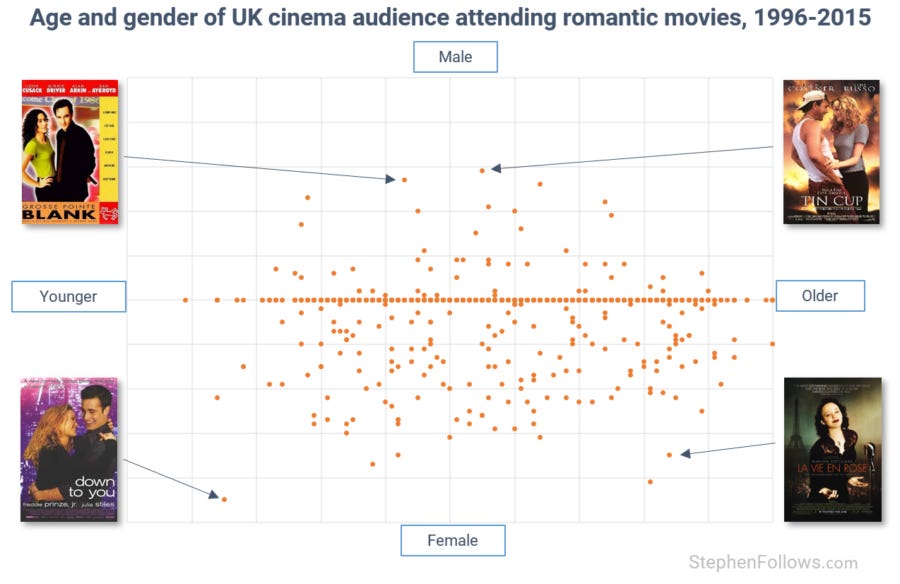Are romantic comedies dying?

Today's article is in response to a question from Jack Malvern at The Times. He got in touch to ask if fewer romantic comedies were being made.
There has been press speculation that the "rom-com" genre is moving away from the big screen and onto subscription VOD platforms such as Netflix. So I agreed to take a look.
For today's research, I am referring to "rom-coms" as films with both the genres of "Romance" and "Comedy". There's more on that classification in the Notes section at the end of the article.
I built datasets of all movies made between 1980 and 2017 (190,544 movies), identified which had grossed at least $1 at the US box office (13,159 movies) and out of those I included any which fitted my definition of a rom-com (1,715 movies).
Who loves love more - filmmakers or film fans?
Across the almost four decades that I studied, romantic comedies made up 4.4% of all feature films made. However, they accounted for 13% of all movies which reached US cinemas. This means that the demand for such films is stronger than the supply.
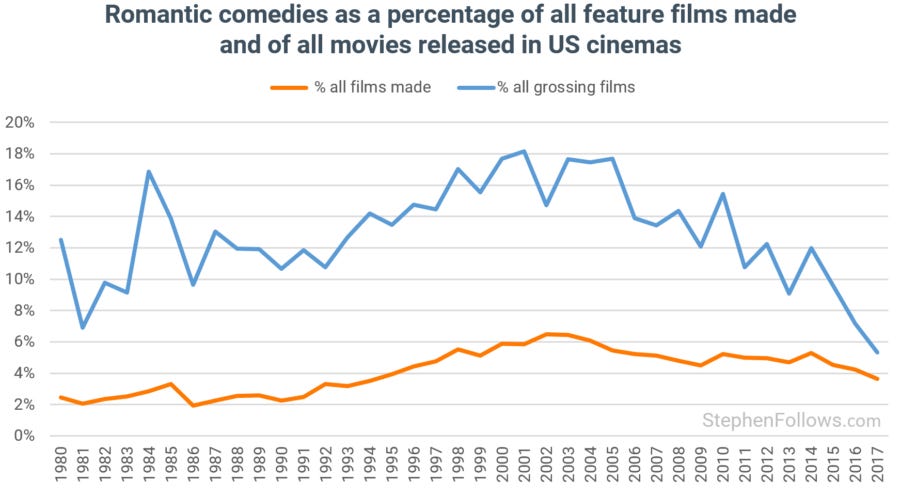
As the eagle-eyed among you will already have spotted, the number of rom-coms reaching US cinemas has dropped significantly in recent years. They hit their height in 2001 when just over 18% of movies in cinemas were both romantic and comedic. That was the year of films such as America's Sweethearts, Bridget Jones's Diary, Shallow Hal, The Wedding Planner, Moulin Rouge, Serendipity, Kate & Leopold and Kissing Jessica Stein.
However, since then they've lost their spark, with only 5% of 2017 releases falling into the same category.
As many of you know, the total number of movies reaching cinemas has increased massively in the past decade or so. Despite this, it's not just a case of other movies swamping the rom-com - the raw numbers are down considerably too, from 76 in 2001 to just 25 in 2017.
Not only is the number of movies falling, so too are the box office receipts. The chart below shows the number of rom-coms released as a percentage of all movies in US cinemas and the percentage of the US box office being collected by such films.
As you can see, the box office receipts have been falling faster in recent years. This suggests that it's not a case of studios choosing not to make rom-coms but that cinema audiences are falling out of love with the rom-com.
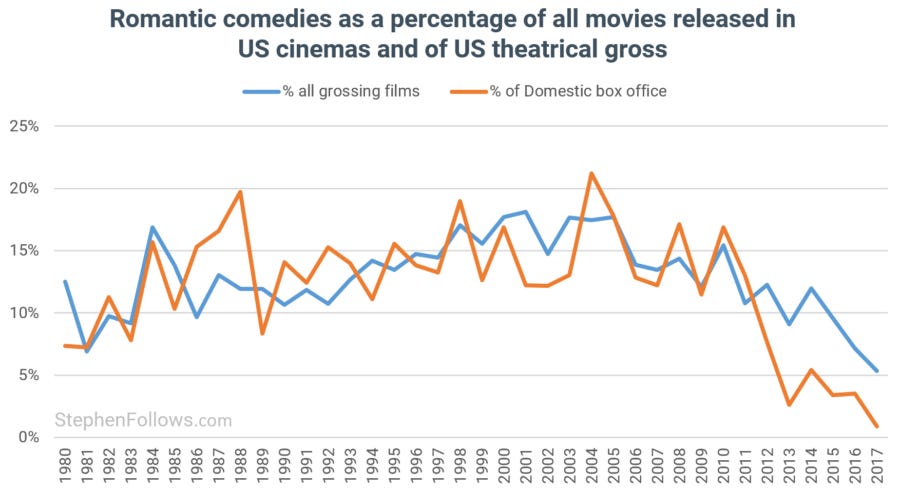
On average, rom-coms are not grossing as much as they used to. Below is a chart of the inflation-adjusted average gross for rom-coms in US cinemas. (I've added a linear trend line in blue to make it clearer what's happening).
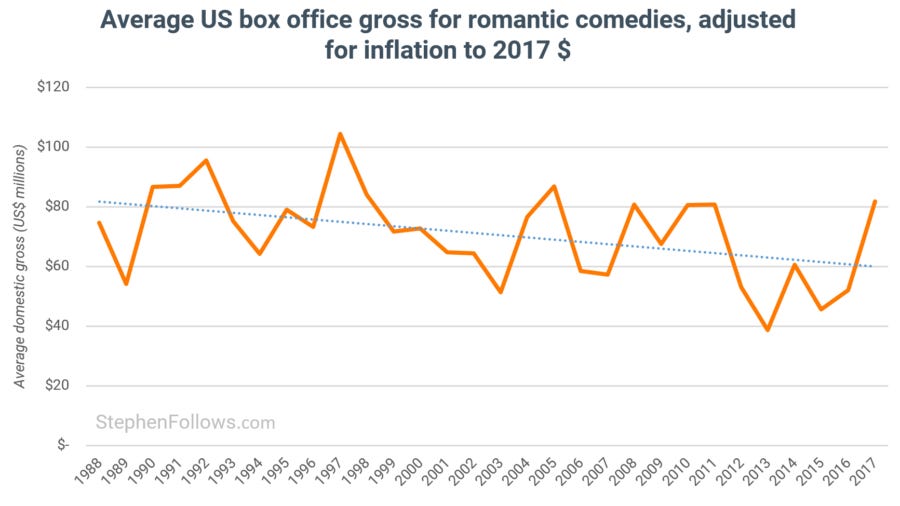
Will the relationship between Comedy and Romance survive?
So what's the future for the partnership of romance and comedy on the big screen? Well, in and amongst a sea of sad news, I offer one glimmer of hope.
In order to see it, we need to look at where rom-coms have been coming from. I returned to my dataset of all feature films made and focused just on romantic films. This allowed me to look at the top producing countries and see what percentage of the romantic films they produce are also comedies.
The country which has historically found love the funniest is... America. Just over half of all romantic feature films made in America are also comedies. This is starkly different from the output of Japanese filmmakers (where rom-coms make up only 25% of romance films) or that of filmmakers in Turkey (25%) or India (26%).
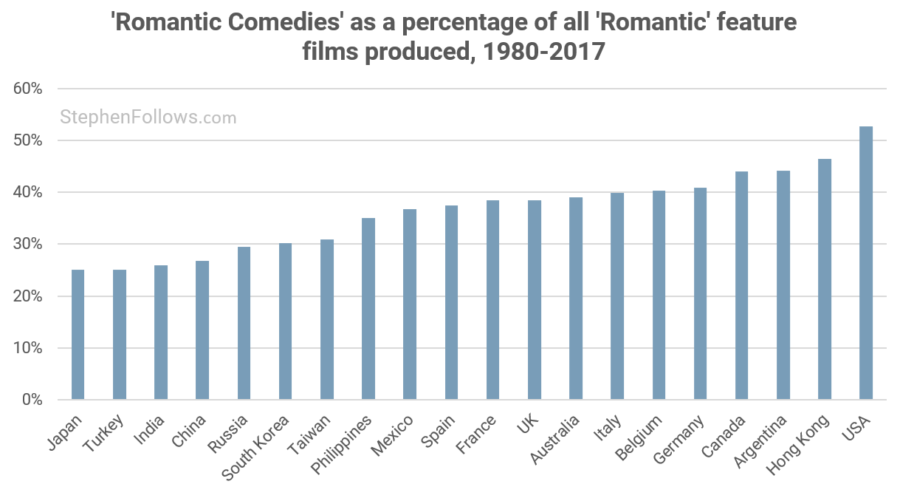
Although America is out in front, the more recent trend is downward. In 2003, 62% of American romantic films were also comedies, whereas in 2017 this had fallen to 49%.
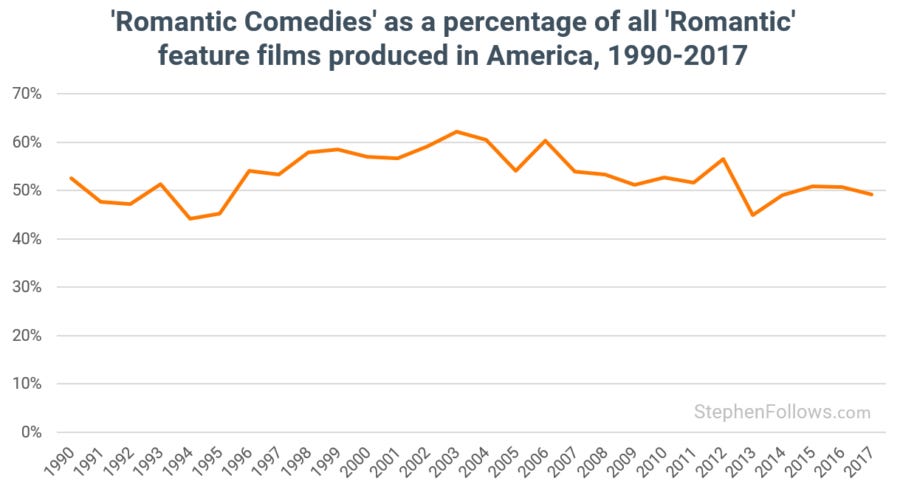
The reverse trend can be seen in the second largest producer of movies - India. In 2003, rom-coms accounted for 22% of their romantic films whereas last year it was 35%.
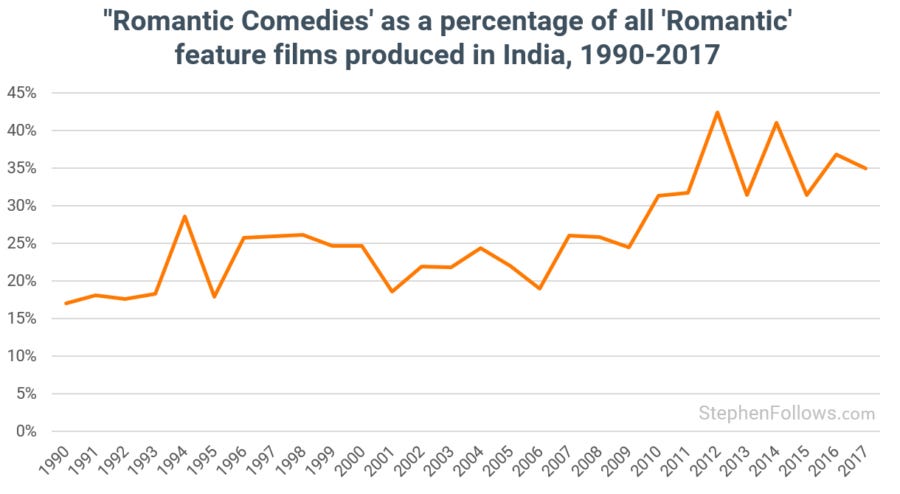
If we use some pretty crude maths, extrapolating from the 38-year average, then we may predict that America's place as 'Top Lover' of rom-coms only has about 20 years left to run. A tragic end to a loving, long-term relationship. But opening your heart to new possibilities is what rom-coms are all about and maybe... just maybe... this new rom-com lover can make audiences learn to love the genre again.
Notes
The data for today's research came from IMDb, The Numbers/Opus and Wikipedia, and the chart at the end is based on data from Pearl and Dean.
I've deliberately defined "rom-com" pretty broadly. I classified films as such if they are referred to both "Comedy" and "Romance" on IMDB (the site does not have a 'romantic comedy' genre classification). The Numbers does have a dedicated "Romantic Comedy" classification but for this particular study I felt it was too narrow. That would have reduced the focus of today's research from 1,715 grossing romantic comedies (1980-2017) to a pool of just 323 and left out movies such as Sweet Home Alabama, Crazy, Stupid, Love and Stranger Than Fiction. As you can see from these examples, "rom-com" can be in the eye of the beholder, and it all depends on how you weight the "rom" and the "com" in each movie. I did check how this decision affects the trends shown here today and they show similar patterns, even with the tighter definitions (as you can see here).
Epilogue
A few years ago, I looked at the demographics of UK cinema audiences of each major genre. Overall, 59% of the UK cinema audiences (1995-2015) for romantic films are female.
However, there were a few outlier movies which managed to attract a plurality of men to see them. See below for the spread of demographics for the movies in the study. A movie right in the centre would indicate that exactly half the audience were men, half were women, half were over 24 years old or older, and half were under 24 years old.
So what did the two biggest gender outliers have which attracted so many men? Guns and sport.
